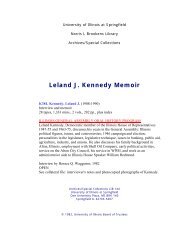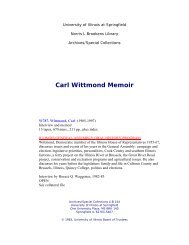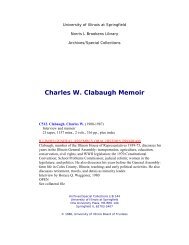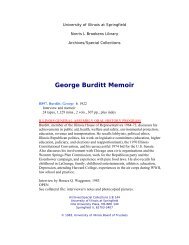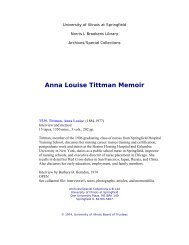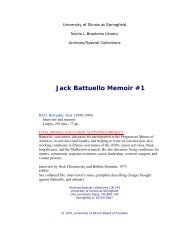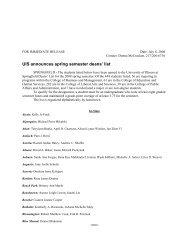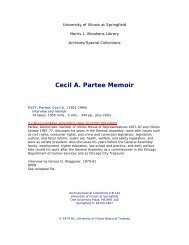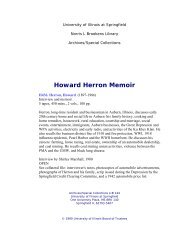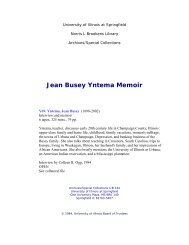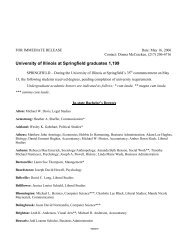Charles C. Patton Memoir - University of Illinois Springfield
Charles C. Patton Memoir - University of Illinois Springfield
Charles C. Patton Memoir - University of Illinois Springfield
Create successful ePaper yourself
Turn your PDF publications into a flip-book with our unique Google optimized e-Paper software.
8. No, how old were YOU with the kids.<br />
A. How old was I at the time? I suppose I was fifty, But*I did<br />
this for a number <strong>of</strong> years, and. . .<br />
Q. When did you stop riding?<br />
A. Oh, about five years ago. It got where it was too painful.<br />
I had problems with my back, with arthritis, and it just got too<br />
painful to do that. But I did ride across the Lo10 Trail, the<br />
most difficult part <strong>of</strong> the Lewis and Clark trail. Where Lewis<br />
and Clark had the most trouble, was getting across the mountains<br />
about where Missoula, Montana is, across into Idaho, and I. .<br />
The Lo10 Trail is a prehistoric Indian Trail used for centuries<br />
by the Columbia River tribes to cross the mountains to the<br />
buffalo country where they could get buffalo to provide<br />
themselves with food and clothing for the winter, then come back<br />
over the mountains to winter along the Columbia River. There was<br />
a packer on the Idaho side. He said he would like to start a tour<br />
there across the mountains. He'd get people to ride across and<br />
I was on the first tour with him, and we went across the most<br />
difficult part on horseback, and it was a delightful ride. It<br />
was difficult, and it was interesting because we saw all the<br />
sights that Lewis and Clark recorded as they went across on<br />
horses. They'd gotten horses from the Shoshone indians and<br />
packed across the trail there.<br />
I did that twice and it's interesting, On the first trail<br />
ride that the outfitter did, he was only able to attract four<br />
people and there were two ladies from Lewiston, Idaho, I think<br />
both <strong>of</strong> their husbands were doctors, but they were divorced, I<br />
don't know. But the third lady was a lady I knew, who came from<br />
New Jersey, and was with the Lewis and Clark Trail Heritage<br />
Foundation. She was a very good photographer and so I convinced<br />
her to go along with us to take pictures, and she disappainted me<br />
because she forgot to bring her colored film. All she had was<br />
black and white. Made me mad as hell! But we crossed anyhow,<br />
and she took a lot <strong>of</strong> pictures. Two years later, there was<br />
another lady from the Lewis and Clark Trail Heritage Foundation<br />
who had been the secretary <strong>of</strong> the Foundation and who wanted to do<br />
this ride and was trying to get enough people together so that<br />
they, so that the people, who ran it could make enough money to<br />
pay for it. It didn't seem as though they were getting enough.<br />
So she called me up and asked "Would I like to came and do it<br />
again?" So I said, "sure", so I went again. Well, they had a<br />
whole bunch <strong>of</strong> dentists who were going to go, but their plans<br />
pooped out, and we ended up, again, with just me and the three<br />
girls. So, both times I went, it was just me and three girls.<br />
Well, I guess I was fortunate, and I have some pictures <strong>of</strong><br />
Well, the point where Lewis and Clark first saw, was the d<br />
<strong>of</strong> the Columbia River, and knew that they were on their w<br />
hill to the Pacific was called Sherman's Peak. When you'd<br />
an the Sherman's Peak, you could see the headwaters



